| Medium |
Name |
Comments |
Region |
Registered |
Image |
| Ceramics | Bizen-yaki (備前焼)[60][61][62][63] | High-fired, unglazed stoneware; one of the six ancient kilns; production in and around Imbe village from the twelfth century | Okayama Prefecture | 2004 |  |
| Ceramics | Hakuji (白磁)[62][64] | Undecorated white porcelain; influenced by Chinese examples; production began in the Arita area in the first half of the seventeenth century | | 1995 | |
| Ceramics | Iro-Nabeshima (色鍋島)[65][66] | A type of iro-e overglaze enamel, often with a blue under-glaze; from the domain of the Nabeshima clan; production from the second half of the seventeenth century | Saga Prefecture | 1976 | 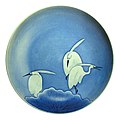 |
| Ceramics | Kakiemon (nigoshide) (柿右衛門 (濁手))[62][66][67][68] | A type of iro-e overglaze enamel; created by Sakaida Kakiemon in the 1640s; nigoshide, the white ground against which the enamels are applied, was revived by Sakaida Kakiemon XII in the 1950s | Saga Prefecture | 1971 |  |
| Ceramics | Mumyōi-yaki (無名異焼)[69][70][71] | Mumyōi is the red ferrous clay of Sado island; production in Aikawa from the early nineteenth century | Niigata Prefecture | 2003 | |
| Ceramics | Onta ware (小鹿田焼)[72][73][74] | Thick slipware; production in Hita from the early eighteenth century; one of the 100 Soundscapes of Japan | Ōita Prefecture | 1995 | 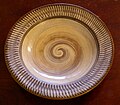 |
| Ceramics | Seto-guro (瀬戸黒)[62][75][76] | Black Seto; the colour is obtained by removing the glazed vessel from the kiln at the height of firing and cooling it rapidly; production in Mino Province from the late sixteenth century | Gifu Prefecture | | |
| Ceramics | Seiji (青磁)[62][77] | The pale-green colour of celadon is obtained from a feldspathic glaze and reduction firing; introduced from the continent | | 2007 |  |
| Ceramics | Shino (志野)[62][78][79][80] | Stoneware with a white feldspathic glaze; production in Mino Province from the late sixteenth century | Gifu Prefecture | 1994 |  |
| Ceramics | Tetsuyū-tōki (鉄釉陶器)[81] | Iron-glaze stoneware | | 2005 | |
| Ceramics | Yūri-kinsai (釉裏金彩)[62][82] | Gold leaf or gold enamel is applied to a glazed surface which is then glazed and fired again, enhancing the durability of the decoration | | 2001 | |
| Textiles | Ise-katagami (伊勢型紙)[83] | Paper stencils | Mie Prefecture | 1993 |  |
| Textiles | Kijōka-bashōfu (喜如嘉の芭蕉布)[84][85] | banana fibre cloth | Okinawa Prefecture | 1974 | 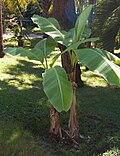 |
| Textiles | Kumejima-tsumugi (久米島紬)[86] | pongee/kasuri | Okinawa Prefecture | 2004 | |
| Textiles | Kurume-kasuri (久留米絣)[87] | | Fukuoka Prefecture | 1957 | |
| Textiles | Miyako-jōfu (宮古上布)[88] | | Okinawa Prefecture | 1978 | |
| Textiles | Tate-nishiki (経錦)[85][89] | Vertical brocade of ancient origin, revived by Kitamura Takeshi | | 2000 | |
| Textiles | Yūki-tsumugi (結城紬)[90][91] | Inscribed on the UNESCO Representative List of the Intangible Cultural Heritage of Humanity in 2010 | | 1956 | |
| Textiles | Kenjō Hakata weave (献上博多織)[92] | | Fukuoka Prefecture | 2003 | |
| Textiles | Edo komon (江戸小紋)[85][93] | Edo fine pattern; stencil resist dyeing technique popular in the Edo period | | 1978 |  |
| Textiles | Bingata (紅型)[85][94] | Stencil or resist paste weave; in the eighteenth century its use by commoners was restricted | Okinawa Prefecture | 1996 |  |
| Textiles | Saga-nishiki (佐賀錦)[85][95] | Brocade that developed in the early nineteenth century and was widespread by the early twentieth | Saga Prefecture | 1994 |  |
| Textiles | Embroidery (刺繍, Shishū)[96] | | | 1997 |  |
| Textiles | Shuri weave (首里の織物)[97] | | Okinawa Prefecture | 1998 | |
| Textiles | Ojiya-chijimi - Echigo-jōfu (小千谷縮・越後上布)[98][99] | Inscribed on the UNESCO Representative List of the Intangible Cultural Heritage of Humanity in 2009 | Niigata Prefecture | 1955 | |
| Textiles | Seigō Sendai-hira (精好仙台平)[100] | | Miyagi Prefecture | 2002 | |
| Textiles | Tsumugi weave (紬織)[85][101] | Woven from hand-spun silk floss | | 1990 | |
| Textiles | Bashōfu (芭蕉布)[85][102] | Bashō-fibre cloth | Okinawa Prefecture | 2000 | |
| Textiles | Mokuhanzuri-sarasa (木版摺更紗)[103] | | | 2008 | |
| Textiles | Monsha (紋紗)[104][105] | Figured gauze weave silk | | | |
| Textiles | Yūzen (友禅)[85][106][107] | Paste-resist dyeing; perfected around 1700 by Miyazaki Yūzen | | 1955 | |
| Textiles | Yūsoku weave (有職織物)[108] | | | 1999 | |
| Textiles | Ra (羅)[85][109][110] | A form of gauze weave; examples are found in the Shōsōin | | 1995 | |
| Lacquerware | Chinkin (沈金)[111][112][113][114] | Incised and filled with gold leaf or powder applied over wet lacquer; popular in China from the Song dynasty and particularly associated with Wajima ware | | 1999 |  |
| Lacquerware | Kinma (蒟醤)[112][115][116] | Incised and colour-filled; introduced from the continent, prized in the Muromachi period, and perfected around Takamatsu in the Edo period | | 1985 | |
| Lacquerware | Kyūshitsu (髹漆)[117][118] | Sequential lacquering technique with four main phases: substrate, priming, intermediate coating, and top coating | | 1974 | |
| Lacquerware | Maki-e (蒔絵)[112][119][120] | Sprinkled picture decoration using metallic powder or pigment; dates to the Heian period | | 1955 |  |
| Lacquerware | Raden (螺鈿)[112][121][122] | Shell (Mother-of-pearl, abalone, nautilus) inlay | | 1999 | |
| Lacquerware | Wajima-nuri (輪島塗)[114][123][124] | A mixture of burned diatomaceous earth, rice paste, and lacquer is used for the layers of undercoat; the earliest example, the doors of Juzo Jinja, date to 1524 | Ishikawa Prefecture | 1977 | 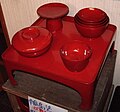 |
| Metalwork | Metal chasing (彫金, chōkin)[125][126] | Several engraving techniques have been practised since the dōtaku of the Yayoi period | | 1978 |  |
| Metalwork | Metal casting (鋳金, chūkin)[127][128] | Several casting techniques have been practised since the dōtaku of the Yayoi period, including lost-wax casting | | 1993 |  |
| Metalwork | Sword Polishing (刀剣研磨, tōken kenma) | | | 1975 | |
| Metalwork | Dora (銅鑼)[129] | Gongs | | 2002 | 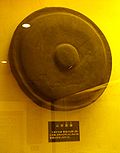 |
| Metalwork | Repoussé (鍛金, tankin)[130][131] | | | 1995 | |
| Woodworking | Bamboo-work (竹工芸
ちくこうげい)[132] | | | 1982 | |
| Woodworking | Wood-work (木工芸
もくこうげい)[133] | | | 1984 | |
| Dolls | Ishō-ningyō (衣裳人形)[134][135] | Costume dolls, dressed in tailored clothing made from dyed and woven textiles | | 1986 | |
| Dolls | Tōso-ningyō (桐塑人形)[135][136] | Paulownia sawdust, mixed with wheat starch and plum paste, is used to form a plaster for casting; once dry it is hard enough to be sculpted | | 2002 | |
| Washi | Echizen-hōsho (越前奉書)[137][138][139] | High-quality paper, used for official orders since the Muromachi period; paper-making in the region is known from the Engishiki | Fukui Prefecture | 2000 | |
| Washi | Hon-Minogami (本美濃紙)[140][141] | Mulberry paper from Mino Province; records in the Shōsō-in refer to three paper-making regions: Chikuzen Province, Buzen Province, and Mino Province | Gifu Prefecture | 1969 | |
| Washi | Hosokawa-shi (細川紙)[142] | | | 1978 | |
| Washi | Najio-ganpishi (名塩雁皮紙)[143][144] | Made from the ganpi plant | Hyōgo Prefecture | 2002 | |
| Washi | Sekishū-banshi (石州半紙)[145][146] | The strongest paper produced in Japan; used for shōji, calligraphy, and conservation-restoration; inscribed on the UNESCO Representative List of the Intangible Cultural Heritage of Humanity in 2009 | Shimane Prefecture | 1969 | |
| Washi | Tosa-tengujōshi (土佐典具帖紙)[147][148] | A very fine, strong paper developed around 1900 by Genta Yoshii | Kōchi Prefecture | 2001 | |
|





























